Titanic parallels with 9/11 (II)
by Tapestry
Read the first part of the article
If we study the path of the Titanic, we quickly come to realize she was never far enough north to hit an iceberg in mid-April.
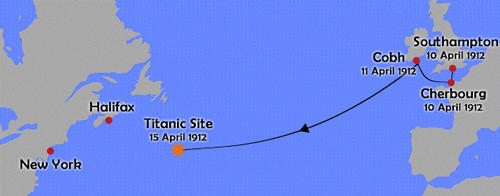
She wasn’t taking the polar route, was she? No, as you can see, the Titanic site is at about the same latitude as New York City or Madrid, Spain, or Rome, Italy. The exact latitude is given as 41.7° north. New York City is at 40.4. Have you ever spotted an iceberg off the coast of New York in April? I didn’t think so. How about Boston? No. Also remember that the Gulfstream is warm, and it moves north in the North Atlantic. You may wish to visit the Wiki page on Gulfstream, where you will see this lovely graphic:
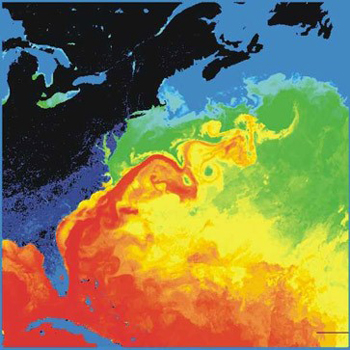
The subtext there is: “Surface temperatures in the western North Atlantic. The North American landmass is black and dark blue (cold), while the Gulf Stream is red (warm). Source: NASA”
NASA tells us: Warm. More research tells us red is 25°C, yellow is 20, green is 15. Even at green, that is a water surface temperature of almost 60°F. 25°C is 77°F. Hello! Are you awake? Ships follow the Gulfstream across the Atlantic on purpose, and always have. Check out old Ben Franklin’s map of the Gulfstream, noting how it curves and goes over toward Europe. Also note the little ships on it.
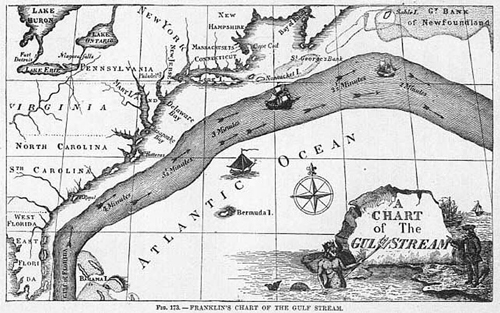
Ships simply don’t hit icebergs at 41.7 N in mid-April in the Gulfstream. No ship before the Titanic ever had. And of course the Titanic didn’t either. Only complete idiots would believe such a story. For the Titanic to encounter icebergs in April, it would have had to be hundreds of miles off-course, up north by Newfoundland. There, around the shallow Great Banks of Newfoundland, the Labrador Current comes down and nullifies the warm water of the Gulfstream. But the Titanic wasn’t within 400 miles of that area.
Also return to the NASA graphic. Notice that the waters are actually colder near the coast of New York and Boston than further out where the Titanic was. So if you haven’t seen any icebergs floating around off the coast there in April, you would be even less likely to see them hundreds of miles out.
They actually have an alleged photo of the iceberg that hit the Titanic:
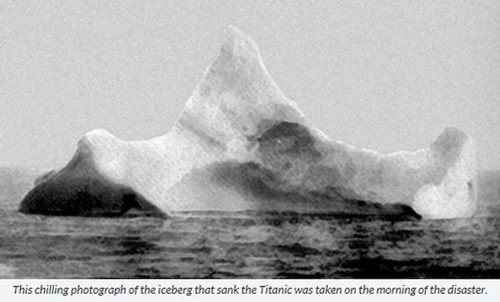
They would need to, wouldn’t they, since all the rescue ships could easily photograph the thing? However, that couldn’t be a more obvious fake. Nothing about it looks real. Even the water looks fake. There is no resolution, lots of fake pixellation or something, and no depth of field. The light also makes no sense. On your far right, the light appears to be coming from low and right, giving us a bright spot on that small wall. But none of the other facets match that reading, telling us this was faked by someone who had never studied light falling on an object.
Wikipedia tells us there is a red spot indicating where the Titanic hit it. I see a shadow on the thing, but since the shadow continues on down across the ocean in a line, it can’t be either the mark they are talking about, or real. Regardless, the iceberg doesn’t look large enough to sink the Titanic, surviving with only “a red smudge”. That ship had a displacement of above 50,000 tons and a cruising speed of about 25mph. The force of such a collision could easily split an iceberg that size. The Titanic’s prow was very pointed, remember, and was the most heavily reinforced part of the ship, for obvious reasons. Prows always are, since they will usually take a first hit.
Plus, you have to compare that iceberg to the stories we have been told about the hit. We have many survivor stories, you know. We are told some passengers felt the hit and others didn’t. They were asleep and slept through it. So we are led to believe it was a glancing blow by a submerged iceberg, with the ship just passing over it and being ripped into. If the ship had hit an iceberg much larger than it, as hitting a wall, no one would have slept through it, no one would have survived, and no stories would have been told. If you stop a 50,000 ton object cold from 25mph, the devastation would be enormous, both on the ship and on the iceberg. The iceberg would have pieces of ship buried in for many feet, and other parts would have exploded all over the front of the iceberg. So that photo is just proof the story is false and that we are looking at a huge fake.
We are now told the ship simply nudged the far edge of the iceberg with its starboard side, not puncturing the hull, but only breaking the seams of five outer compartments. The ship could only survive the breach of four, we are told in a bit of irony. However, this conflicts mightily with what we are told of the Titanic’s miraculous design – and why it was considered unsinkable. These outer compartments were sealed off from inner compartments, so pretty much all the outer compartments on the forward starboard could have been breached without sinking the ship. The outer compartments were like bumpers, and they weren’t connected to the inner ship. This “unsinkable” idea is now sold as a myth, but even those selling it as a myth admit that White Star VP Franklin called the ship unsinkable. The publicity brochures for the boat called it unsinkable. So it was hardly a myth. And it was basically true. The Titanic’s twin Olympic was rammed by the 8000 ton military cruiser HMS Hawke, crushing the Hawke but never imperiling the Olympic. These huge ships were built to withstand incredible collisions, and the Titanic should have easily withstood the collision, even as it is now sold in the literature. This malarkey about four compartments maximum has no basis in fact: it does not match what was said of these ships before 1912. And besides, if the Titanic hit the right edge of that iceberg above, it would not compromise more than four compartments. It would also not just leave a little red dot on the iceberg. Whoever composed this story is an idiot, or thinks you are.
Plus, where does the “red” come in? The Titanic was red below the water line, but black above, and yet they have indicated a red smudge above the water line on that fake iceberg. I now see it is the dot on the far right wall, in the bright patch, about halfway up. But for the iceberg to be large enough to damage the Titanic, that dot would have to be twenty or thirty feet up – above the water line. So why would it be red?
As a bonus, I include here the images we are given of the Olympic and Hawke after the collision.
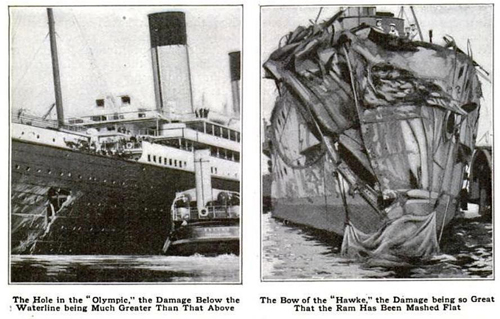
Strangely, those are fake as well. The picture of the Hawke is obviously a painting: look at the funny little men onboard, and note how the water looks like an impressionist painting! The picture of the Olympic isn’t a painting, but it looks like a manipulated paste-up with fake damage drawn in. If this collision was also a fake, that pushes us down yet another level in the rabbit hole, doesn’t it?
And another part of the story falls with our Gulfstream graphic above. The mainstream admits the Carpathia arrived less than two hours after the Titanic went down. So why couldn’t she rescue the people in life vests as well as the people in boats? Why did the Canadians have to find them all dead a few days later? We are told they froze to death in less than two hours, but our Gulfstream graphic puts the lie to that as well, doesn’t it? This was 50 or 60 degree F water, which is quite cold but not cold enough to kill you in less than two hours. So the lie here is huge: the mainstream story tells us the water temp was subfreezing, being -2°C or 28°F. Not even close to being true, as we have seen. The Titanic was traveling in the warm Gulfstream, which was around 15°C almost all the way across the Atlantic. Even the cooler parts of the Atlantic at that latitude aren’t subfreezing on the surface.
Of course the movie Titanic was made to push again all these old lies. We saw Leo DiCaprio freezing to death in icy water in a short time, didn’t we? Impossible, because he would have been floating in NASA’s “warm” Gulfstream at latitude 41.7° N. But they want you to think he was floating at about 60°N, up by Greenland. I am just surprised director Cameron didn’t CGI in some polar bears swimming by.
Actually, this idea was used to sell the event. See Daisy Spedden’s children’s book Polar the Titanic Bear, published in 1994. Spedden was an American heiress who supposedly survived the Titanic and she allegedly wrote the book in 1913 to amuse her 7-year-old son. He allegedly died in a car accident in 1915, so the book was shelved. It was allegedly found by a relative and published by Little Brown in 1994 and then republished by Scholastic Books in 1998. This by itself indicates we are dealing with another Intel project, since Scholastic Books publishes both Harry Potter and the Hunger Games. The first Potter came out in 1997, the year before Scholastic began pushing this Polar the Titanic Bear rubbish.
Which brings us to the USS Californian, famous for failing to respond to flares seen from the Titanic. Several inquires were made into this, but the only possible answer is that the Californian was ordered to stand down and not to assist. Ordered by whom? By J.P. Morgan, who owned the Leyland Line as well as the White Star Line. Despite both the British and American inquiries finding that the Californian could have saved all or most of those who perished in life vests, the officers were never charged with negligence or any other crime. They were never sued. This also can only be explained by top-down pressure by the billionaires, who wished to bury this part of the story.
We are told the Californian was so close she could see the Titanic and the Titanic could see her. But we are supposed to believe neither ship was able to signal the other. No one thought to wake the sleeping wireless operator on the Californian! Oh, the things they expect you to believe!
The story of the Californian has since been tweaked to sell the story that there was ice in the area, and the ship was stopped due to it. But we have seen that was impossible.
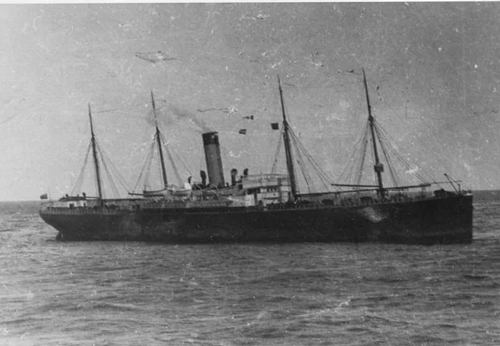
USS Californian, 20 miles away and with very few passengers on board,
could have easily rescued the people on Titanic
Also interesting is the name of the captain, Stanley Phillip Lord. His son Stanley Tutton Lord was a banker in Liverpool. This reminds us of agent Sterling Lord, from a paper on the Jeffrey MacDonald fake. Sterling Lord was from the peerage, and we may assume the same of Stanley Lord. He is not listed in the peerage, but that doesn’t mean they aren’t related. Lord is very scrubbed, but I did find one possible clue. His wife was a Tutton, and there are Tuttons in the peerage. A Francis Robert Tutton, b. 1874, married Lucy Evans Chavasse, her mother being Frances Evans. This is curious because Capt. Stanley Lord’s wireless operator was one Cyril Evans, indicating the two men may have been related. In fact, we do find a Cyril Lloyd Evans in the peerage, possibly of the right age for a match. He is scrubbed, the only thing we know about him being that his daughter’s middle name was Murray—which may have been her mother’s maiden name—and that she married the Baronet Bowen. Of course that is a clue, since that name already came up above. See Vice-Admiral Harold Gardiner Bowen of the ONR, possibly linked to Robin Gardiner who wrote the book on the Titanic switch. Anyway the first Baronet Bowen ran the Great South Railway in Argentina at the time of our story. His daughter married the son of Lt. Gen. Sir Alexander Cobbe, who in turn was the son of Nuzzeer Begum Khan.
Also remember Walter Lord, who published the bestseller A Night to Remember in 1955, about the Titanic event. He was later a consultant to James Cameron for the 1997 film. Wikipedia admits he was OSS, the precursor to CIA. Lord’s mother was a Hoffman, very likely making him Jewish, and his grandfather was Richard Curzon Hoffman, President of the Baltimore Steam Packet Company—a steamship firm. Do you recognize the name Curzon? We saw it above, didn’t we? We saw the 2nd Baronet Smith/Bromley marrying the daughter of the Viscount Curzon. This pretty much proves Walter Lord was related to all these people.
What this indicates to me is that Lord and Evans on the Californian were related and were both MI5/6. They were planted on the ship specifically to oversee the wreck. Along with the Carpathia, they were on hand to make sure the event went as planned. So I don’t think Lord was falsely accused, but I do think he was just following orders. Lord didn’t pick up anyone because there was no one to be picked up. The Carpathia was the designated pick-up ship, and she picked up all crew and cast, leaving no one in the water. The Californian wasn’t there to pick anyone up, she was there as the coordination vessel, and possibly as back-up. She may have warned off any other ships, telling them this was a military exercise or something.
Then Wikipedia tells us the next stunning lie. The captain of the Carpathia described the area around the Titanic wreck as a vast ice field with many icebergs and ice floes. If so, then what were all these other ships doing there in the first place? Why was Carpathia there at all, and how did she get in to the Titanic? Are we supposed to believe she was an icebreaker? We are then told that this area is now called Iceberg Alley. However, all we have to do is take the link to see that isn’t the case. Iceberg Alley exists, but it is far to the north. It isn’t at 41.7° N, it is in the Labrador Current, up between Newfoundland and Greenland, as I showed you above. It is about 400 miles north of the Titanic site, running from the 50th parallel to the 60th. Tens of thousands of sailors, navy men, geographers, and historians must know this, so why are you having to hear it from me? For that matter, why didn’t author Robin Gardiner mention any of this in his “hard-hitting and ground-breaking” book? I think you now know why.
yogaesoteric
September 15, 2019
Also available in:
 Français
Français
